One of the issues I have thought both puzzling and key to the events surrounding Richard, Duke of Gloucester’s actions as Protector to Edward V on June 13, 1483 was his summary execution of William Hastings--an execution delivered without, it would seem, due process. From my point of view, this was uncharacteristic action by a man who was for most of his life, all about the rule of law. I struggled to tease apart this event in particular, and the subsequent actions taken by Richard that led him to be crowned king of England. Thus, it was with great anticipation that I opened this book that promised to offer a fresh and intriguing view of the possible motives and reasons that led to Hastings’ execution and Richard’s decision to go after the crown. Hancock did not disappoint.
First, I want comment on the style in which the book is written. It’s like Hancock is speaking with me. This book is highly readable and thoroughly engaging, and whether you agree or not with the theory, it is logically constructed. Hancock was careful to present primary and secondary sources that both substantiated and countered his theory. In the instances where the sources were contrary to his hypothesis, Hancock showed why he thought the interpretation was incorrect or didn’t hold up. He didn’t dismiss these arguments out-of-hand. In all but a small handful of instances, Hancock gives sources to substantiate his position. I will not quibble with a couple of un-sourced statements that were thrown in because they had no effect on the book’s premise.
The book set out to determine when did Richard first decide that he wanted to be King and not protector. The time span Hancock examines was from when Richard first learned his brother Edward IV had died to when Richard was made King on June 26, 1483. Although, Edward IV died April 9, 1483, Richard didn’t learn of it until about a week later. From the time Richard learned of Edward’s death to the council meeting on June 13th, Richard’s actions were consistent with his role as protector. There was no outward indication that he was aiming for anything else. Hancock posits that something happened during that council meeting that changed everything. Per Hancock, Richard learned about the precontracted marriage between Edward IV and Eleanor Butler from William Catesby during a break in the meeting. He also learned that Hastings knew about the precontract. Enraged by this betrayal, Richard returns to the council and accuses Hastings, among others, of treason. However, Hastings was executed that day and the only one to lose his head. Even though I don’t agree with the timing of the events for reasons I won’t go into here, I think the scenario Hancock painted holds together very well.
What I like best about this book is that it is thoughtful and pointed out possible scenarios that I had not considered. Whether or not you will agree with the thesis Hancock lays out in his book, I think it is well worth reading.
Richard III and the Murder in the Tower may be purchased at Amazon.com:
Tuesday, September 29, 2009
Saturday, September 12, 2009
Authors--share your books with our troops
Ed Patterson, an independent author I met at the Independent Author's Guild discussion group has joined with Smashwords to offer our troops in Iraq and elsewhere free access to electronic copies of our books through a program called ePubDrop. You can read the details about this program on the Smashwords blog.
This Time is now available through this program.
This Time is now available through this program.
Thursday, September 10, 2009
Because these are funny
Doctors Notes, lifted from Miss Cellania's blog:
The things doctors have scribbled on patient’s charts when they are in a hurry:
# "Patient has chest pain if she lies on her left side for over a year."
# "On the 2nd day the knee was better and on the 3rd day it disappeared completely."
# "The patient has been depressed ever since she began seeing me in 1993."
# "Discharge status: Alive but without permission."
# "Healthy appearing decrepit 69 year-old male, mentally alert but forgetful."
# "The patient refused an autopsy."
# "The patient has no past history of suicides."
# "Patient has left his white blood cells at another hospital."
# "Patient's past medical history has been remarkably insignificant with only a 40 pound weight gain in the past three days."
# "Patient had waffles for breakfast and anorexia for lunch."
# "She has had no rigors or shaking chills, but her husband states she was very hot in bed last night."
# "She is numb from her toes down."
# "While in the ER, she was examined, X-rated and sent home."
# "The skin was moist and dry."
# "Occasional, constant, infrequent headaches."
# "Patient was alert and unresponsive."
# "She stated that she had been constipated for most of her life, until she got a divorce."
# "I saw your patient today, who is still under our car for physical therapy."
# "The patient was to have a bowel resection. However, he took a job as a stockbroker instead."
# "Patient has two teenage children but no other abnormalities."
# "Skin: Somewhat pale but present."
# "Patient was seen in consultation by Dr. Blank, who felt we should sit on the abdomen, and I agree."
# "By the time he was admitted, his rapid heart stopped, and he was feeling better."
# "The patient was in his usual state of good health until his airplane ran out of gas and crashed."
# "When she fainted, her eyes rolled around the room."
# "Patient was released to outpatient department without dressing."
# "The patient will need disposition, and therefore we will get Dr. Blank to dispose of him."
# "The patient expired on the floor uneventfully."
The things doctors have scribbled on patient’s charts when they are in a hurry:
# "Patient has chest pain if she lies on her left side for over a year."
# "On the 2nd day the knee was better and on the 3rd day it disappeared completely."
# "The patient has been depressed ever since she began seeing me in 1993."
# "Discharge status: Alive but without permission."
# "Healthy appearing decrepit 69 year-old male, mentally alert but forgetful."
# "The patient refused an autopsy."
# "The patient has no past history of suicides."
# "Patient has left his white blood cells at another hospital."
# "Patient's past medical history has been remarkably insignificant with only a 40 pound weight gain in the past three days."
# "Patient had waffles for breakfast and anorexia for lunch."
# "She has had no rigors or shaking chills, but her husband states she was very hot in bed last night."
# "She is numb from her toes down."
# "While in the ER, she was examined, X-rated and sent home."
# "The skin was moist and dry."
# "Occasional, constant, infrequent headaches."
# "Patient was alert and unresponsive."
# "She stated that she had been constipated for most of her life, until she got a divorce."
# "I saw your patient today, who is still under our car for physical therapy."
# "The patient was to have a bowel resection. However, he took a job as a stockbroker instead."
# "Patient has two teenage children but no other abnormalities."
# "Skin: Somewhat pale but present."
# "Patient was seen in consultation by Dr. Blank, who felt we should sit on the abdomen, and I agree."
# "By the time he was admitted, his rapid heart stopped, and he was feeling better."
# "The patient was in his usual state of good health until his airplane ran out of gas and crashed."
# "When she fainted, her eyes rolled around the room."
# "Patient was released to outpatient department without dressing."
# "The patient will need disposition, and therefore we will get Dr. Blank to dispose of him."
# "The patient expired on the floor uneventfully."
Monday, September 7, 2009
My brief but hectic UK trip
Just got back from England and thought I’d take a few minutes to talk about my latest adventures.
My first stop was the Battle of Bosworth reenactment to promote my book, This Time. I met up with two Ricardian friends who formed a partnership called White Boar and to my joy and gratitude have agreed to distribute my book in the UK. The Heritage Center set me up with a small table and although I had some stiff competition from Philippa Gregory who was there signing her latest book, I did manage to sell 14 signed copies of mine. But the best news is the Heritage Center shop bought 10 copies from White Boar for sale at their shop. I signed those copies as well. Then, the cherry on top of the icing on the cake was the Richard III Society’s tent was next to us, and they gave White Boar a spot at their AGM (annual meeting) where more of my books will be available. And Phil Stone, the society’s chairman bought a copy.
It’s a good thing I got to see the reenactment in 2006, because I was pretty much tied to my table the whole time. Except for bio breaks, this was my view of the reenactment.

The second reason for my trip was to do some research for the third book, Strange Times (still a work in progress). To do this, I needed to rent a car because a few of the places I needed to see are not near public transportation or sufficiently out of the way so that I’d eat up my time just getting to a place. My mantra became “keep left, left turn on side, right turn cross over.” I kept repeating it over and over and didn’t have any problems adjusting.
Since the novel begins at the end of the Battle of Stoke with Henry VII’s troops roundly defeating the Yorkist rebels, I had to see and walk over some of the ground where the battle took place. Unfortunately, much of the land is privately owned and being farmed.

Part of the battlefield abuts the River Trent. According to what I’ve read, the far bank is high, which you can see here, but now the bank has a retaining wall, which undoubtedly wasn’t there in 1487.
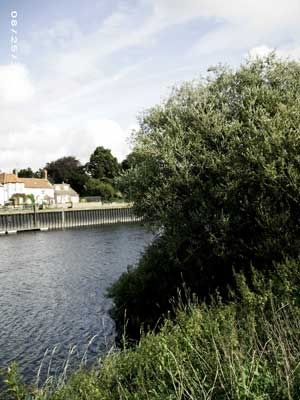
Next research stop was Witney--noted for wool and woolen blanket production--and Minster Lovel Hall, about three miles upstream from Witney on Windrush River.
Buttercross Market Square
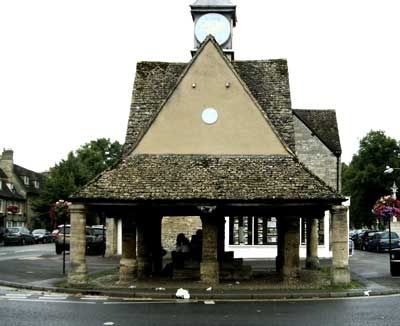
Windrush between Witney and the Cogges, a medieval farm

Minster Lovel Hall from the Windrush

Windrush at the edge of Minster Lovel Hall
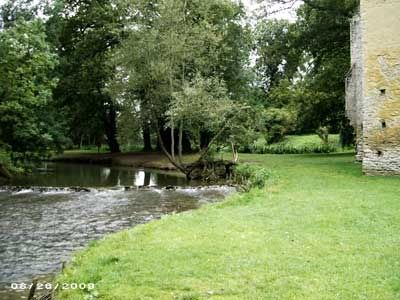
My research for the third book done, I drove to Reading to see my friends from way back and returned the car. I still needed to do a bit of research for an unrelated book, so I split my time between visiting with my friends and taking the train into London. Part of this research brought me back to the tower, but now to see the Royal Chapel of St. Peter ad Vincula where certain headless royalty were buried.
Tower of London from the underground stop
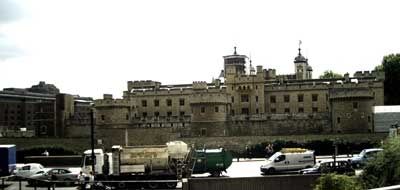
St. Peter ad Vincula (grassy foreground is where several people lost their heads, including William Hastings.
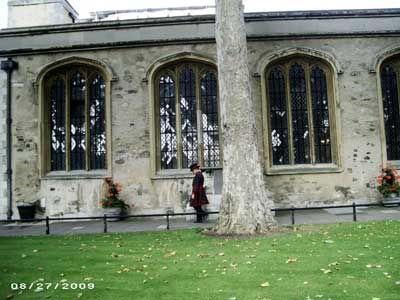
On my last day, I met with Annette Carson and we traded books. She also gave me two signed copies for the US AGM's sales table. Her book, Richard III, the Maligned King is well worth reading. I'm about half way through it and I'm singularly impressed with the quality of research and writing. I plan on reviewing this and Peter Hancock's book shortly.
My first stop was the Battle of Bosworth reenactment to promote my book, This Time. I met up with two Ricardian friends who formed a partnership called White Boar and to my joy and gratitude have agreed to distribute my book in the UK. The Heritage Center set me up with a small table and although I had some stiff competition from Philippa Gregory who was there signing her latest book, I did manage to sell 14 signed copies of mine. But the best news is the Heritage Center shop bought 10 copies from White Boar for sale at their shop. I signed those copies as well. Then, the cherry on top of the icing on the cake was the Richard III Society’s tent was next to us, and they gave White Boar a spot at their AGM (annual meeting) where more of my books will be available. And Phil Stone, the society’s chairman bought a copy.
It’s a good thing I got to see the reenactment in 2006, because I was pretty much tied to my table the whole time. Except for bio breaks, this was my view of the reenactment.

The second reason for my trip was to do some research for the third book, Strange Times (still a work in progress). To do this, I needed to rent a car because a few of the places I needed to see are not near public transportation or sufficiently out of the way so that I’d eat up my time just getting to a place. My mantra became “keep left, left turn on side, right turn cross over.” I kept repeating it over and over and didn’t have any problems adjusting.
Since the novel begins at the end of the Battle of Stoke with Henry VII’s troops roundly defeating the Yorkist rebels, I had to see and walk over some of the ground where the battle took place. Unfortunately, much of the land is privately owned and being farmed.

Part of the battlefield abuts the River Trent. According to what I’ve read, the far bank is high, which you can see here, but now the bank has a retaining wall, which undoubtedly wasn’t there in 1487.

Next research stop was Witney--noted for wool and woolen blanket production--and Minster Lovel Hall, about three miles upstream from Witney on Windrush River.
Buttercross Market Square

Windrush between Witney and the Cogges, a medieval farm

Minster Lovel Hall from the Windrush

Windrush at the edge of Minster Lovel Hall

My research for the third book done, I drove to Reading to see my friends from way back and returned the car. I still needed to do a bit of research for an unrelated book, so I split my time between visiting with my friends and taking the train into London. Part of this research brought me back to the tower, but now to see the Royal Chapel of St. Peter ad Vincula where certain headless royalty were buried.
Tower of London from the underground stop

St. Peter ad Vincula (grassy foreground is where several people lost their heads, including William Hastings.

On my last day, I met with Annette Carson and we traded books. She also gave me two signed copies for the US AGM's sales table. Her book, Richard III, the Maligned King is well worth reading. I'm about half way through it and I'm singularly impressed with the quality of research and writing. I plan on reviewing this and Peter Hancock's book shortly.
Subscribe to:
Comments (Atom)
